
A tractor is an engineering vehicle specifically designed to deliver a high tractive effort at slow speeds, for the purposes of hauling a trailer or machinery such as that used in agriculture, mining or construction. Most commonly, the term is used to describe a farm vehicle that provides the power and traction to mechanize agricultural tasks, especially tillage, and now many more. Agricultural implements may be towed behind or mounted on the tractor, and the tractor may also provide a source of power if the implement is mechanised.
Bobcat Company is an American-based manufacturer of farm and construction equipment. Its American headquarters is in West Fargo, North Dakota, formerly in Gwinner, North Dakota. Its European headquarters moved in 2017 from Waterloo, Belgium, to Dobříš, Czech Republic. It was a subsidiary of the Ingersoll Rand Company from 1995 until July 2007, when it was sold for US$4.9 billion to Doosan Infracore.

A skid loader, skid-steer loader, SSL, or skidsteer is any of a class of compact heavy equipment with lift arms that can attach to a wide variety of buckets and other labor-saving tools or attachments.

Excavators are heavy construction equipment consisting of a boom, dipper, bucket and cab on a rotating platform known as the "house". The house sits atop an undercarriage with tracks or wheels. They are a natural progression from the steam shovels and often mistakenly called power shovels, as power shovels may have similar looking buckets. All movement and functions of a hydraulic excavator are accomplished through the use of hydraulic fluid, with hydraulic cylinders and hydraulic motors. Due to the linear actuation of hydraulic cylinders, their mode of operation is fundamentally different from cable-operated excavators which use winches and steel ropes to accomplish the movements.
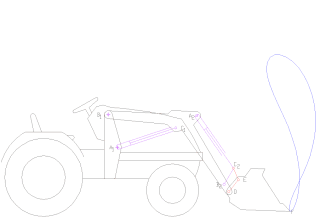
A loader is a heavy equipment machine used in construction to move or load materials such as soil, rock, sand, demolition debris, etc. into or onto another type of machinery.
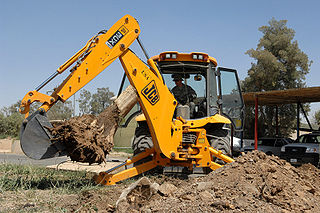
A backhoe—also called rear actor or back actor—is a type of excavating equipment, or digger, consisting of a digging bucket on the end of a two-part articulated arm. It is typically mounted on the back of a tractor or front loader, the latter forming a "backhoe loader". The section of the arm closest to the vehicle is known as the boom, while the section that carries the bucket is known as the dipper, both terms derived from steam shovels. The boom, which is the long piece of the backhoe arm attached to the tractor through a pivot called the king-post, is located closest to the cab. It allows the arm to pivot left and right, typically through a range of 180 to 200 degrees, and also enables lifting and lowering movements.
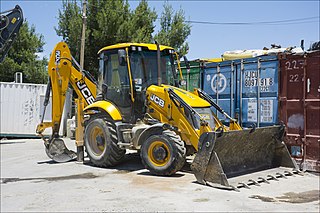
A backhoe loader, also called a loader backhoe, loader excavator, tractor excavator, digger or colloquially shortened to backhoe within the industry, is a heavy equipment vehicle that consists of a tractor-like unit fitted with a loader-style shovel/bucket on the front and a backhoe on the back. Due to its (relatively) small size and versatility, backhoe loaders are very common in urban engineering and small construction projects as well as developing countries. This type of machine is similar to and derived from what is now known as a TLB (Tractor-Loader-Backhoe), which is to say, an agricultural tractor fitted with a front loader and rear backhoe attachment.

Heavy equipment, heavy machinery, earthmovers, construction vehicles, or construction equipment, refers to heavy-duty vehicles specially designed to execute construction tasks, most frequently involving earthwork operations or other large construction tasks. Heavy equipment usually comprises five equipment systems: the implement, traction, structure, power train, and control/information.

Volvo Construction Equipment - Volvo CE - is a major international company which develops, manufactures, and markets equipment for construction and related industries. It is a subsidiary and business of the Volvo Group.
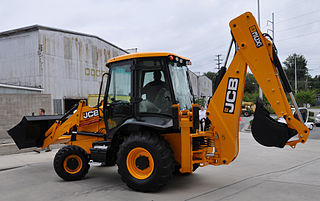
J.C. Bamford Excavators Limited (JCB) is a British multinational manufacturer of equipment for construction, agriculture, waste handling, and demolition. It was founded in 1945 and is based in Rocester, Staffordshire, England.
Joseph Cyril Bamford, CBE was a British businessman. He was the founder of J.C. Bamford Excavators Limited (JCB), a manufacturer of heavy equipment.

Case Construction Equipment is an Italian manufacturer of construction machinery. Along with CASE IH, Case Construction Equipment is a brand of CNH. Case produces construction equipment including excavators, motor graders, wheel loaders, vibratory compaction rollers, crawler dozers, skid steers, and compact track loaders.

The Case Corporation was a manufacturer of agricultural machinery and construction equipment. Founded, in 1842, by Jerome Increase Case as the J. I. Case Threshing Machine Company, it operated under that name for most of a century. For another 66 years it was the J. I. Case Company, and was often called simply Case. In the late 19th century, Case was one of America's largest builders of steam engines, producing self-propelled portable engines, traction engines and steam tractors. It was a major producer of threshing machines and other harvesting equipment. The company also produced various machinery for the U.S. military. In the 20th century, Case was among the ten largest builders of farm tractors for many years. In the 1950s its construction equipment line became its primary focus, with agricultural business second.

BEML Limited, formerly Bharat Earth Movers Limited, is an Indian public sector undertaking which manufactures a variety of heavy equipment, such as that used for earth moving, railways, transport and mining. It is headquartered in Bangalore. BEML is Asia's second-largest manufacturer of earth moving equipment. Its stock trades on the National Stock Exchange of India under the symbol "BEML", and on the Bombay Stock Exchange under the code "500048".
Gravely, of Brillion, Wisconsin, is a manufacturer of powered lawn and garden implements which it describes as "walk-behind, zero turn and outfront mowers". It started as a manufacturer of "walk-behind" or two-wheel tractors.
Muir Hill (Engineers) Ltd was a general engineering company based at Old Trafford, Manchester, England. It was established in the early 1920s and specialised in products to expand the use of the Fordson tractor, which in the pre-war days included sprung road wheels, bucket loaders, simple rail locomotives, and in particular in the 1930s they developed the dumper truck. Later they built high horse power tractors.

Hydrema is a dump truck manufacturer based in Støvring, Denmark, founded in 1959. They have specialized in the manufacture of articulated light dump trucks and earth moving equipment. A variety of models are produced, with a payload of up to 20 tonnes. Since 1996 they are also producing a mine clearing vehicle. A company subsidiary with production is operating in Weimar, Germany.
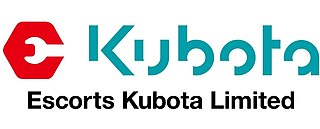
Escorts Kubota Limited formerly Escorts Limited is an Indian multinational conglomerate that operates in the sectors of agricultural machinery, construction machinery, material handling, and railway equipment. Its headquarters are located in Faridabad, Haryana. The company was launched in 1944 and has marketing operations in more than 40 countries. Escorts manufactures tractors, automotive components, railway equipment, and construction and material handling equipment.
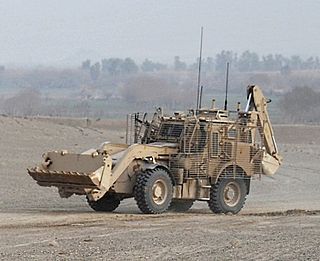
The JCB HMEE is a military engineering vehicle made by JCB.
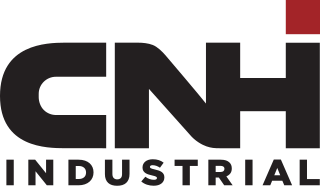
CNH Industrial N.V. is an Italian-American multinational corporation with global headquarters in Basildon, United Kingdom, but controlled and mostly owned by the multinational investment company Exor, which in turn is controlled by the Agnelli family. The company is listed on the New York Stock Exchange and on Borsa Italiana: it is a constituent of the FTSE MIB index. The company is incorporated in the Netherlands. The seat of the company is in Amsterdam, Netherlands, with a principal office in London, England.















